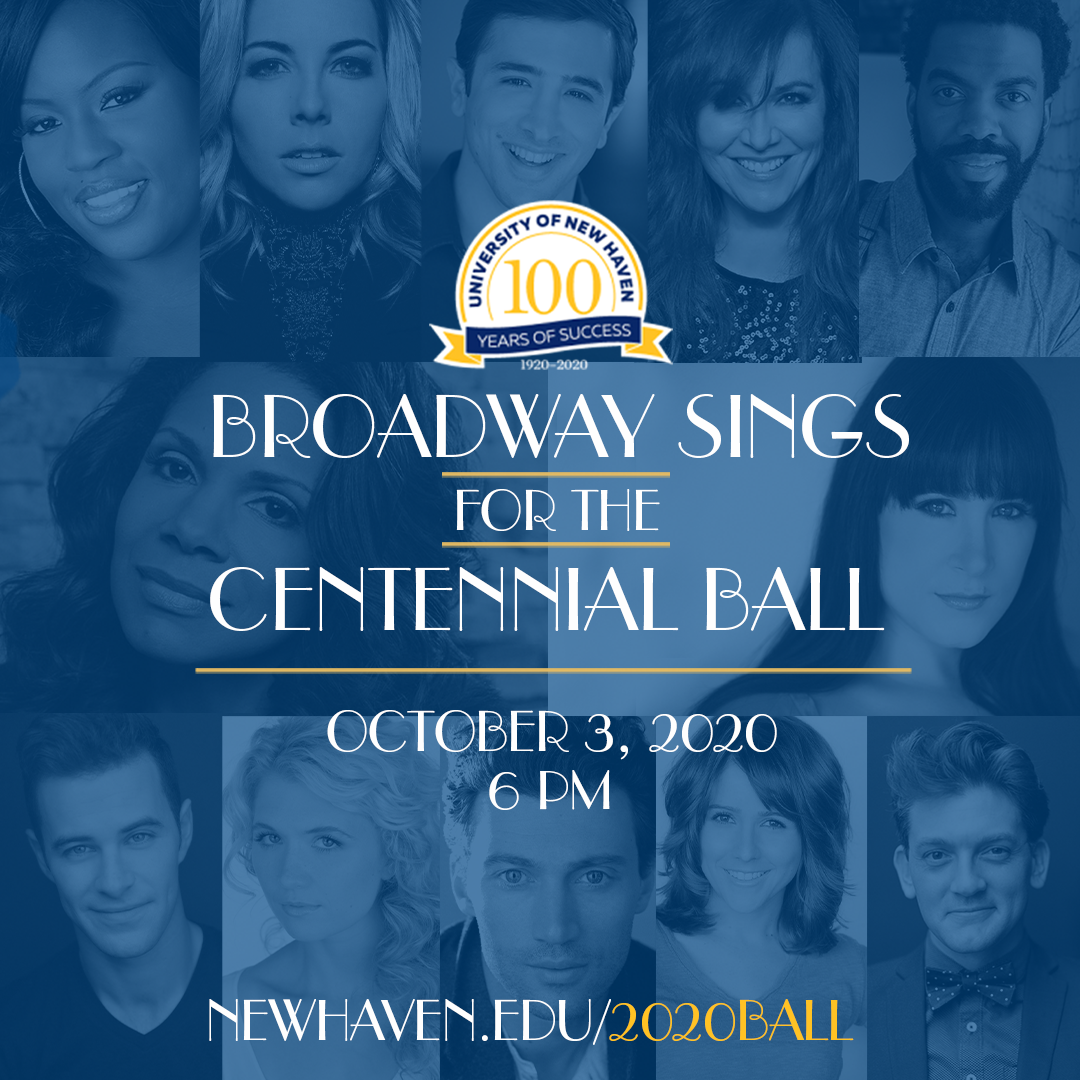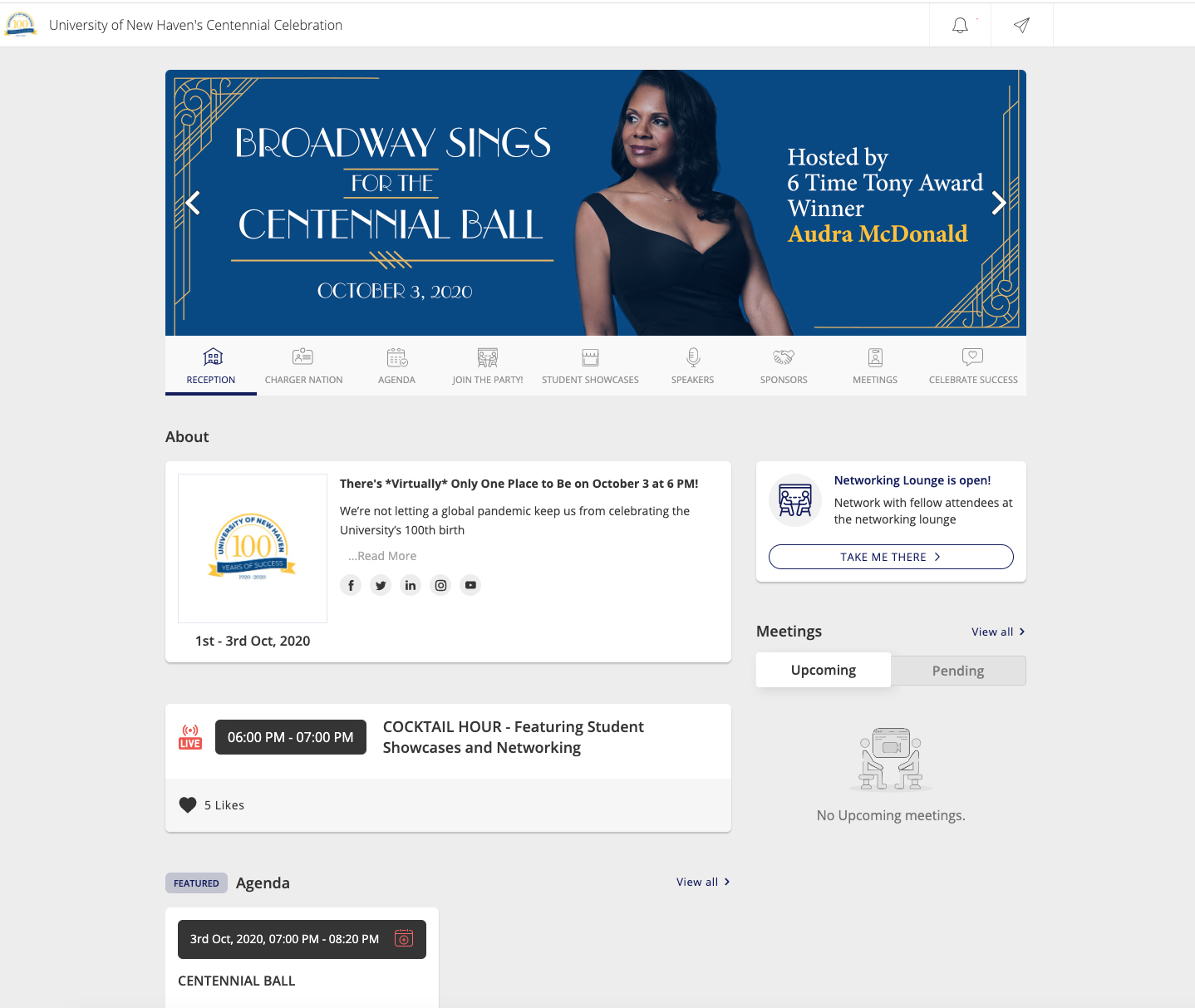Each April for the past 36 years, the University of New Haven held a ball to raise scholarship funds and showcase student work, and in April 2020 a bigger event than usual was in the works. The institution’s Centennial celebrations had begun in the months leading up to 2020 as a way to meet people in cities such as Boston, New York City and Boca Raton and spur interest in attending the main event. Work on the ball had been underway since the summer of 2019.
As the pandemic hit, officials pushed the event to the fall, and as summer approached October 24 was selected. By mid-summer, when it became clear an in-person event would not be possible, the team decided to go all-in on a virtual ball and scheduled it for October 3.
UB asked Stephen Morin, vice president for advancement, to talk through the pivot to planning a large event virtually and what was done to ensure it was a success.
UB: The event description makes clear that this wasn’t intended to be just another Zoom meeting. What work went into ensuring a fun, engaging format?
Morin: The first priority was mindset. We needed to ensure that everyone on our team and across the university had a mindset of pure creativity. We were building something that we, at the start, had no idea what it would ultimately look like. So being able to be creative in this environment was essential.
From a first, and practical standpoint, we tested a number of platforms that had the greatest capabilities to handle what we wanted to accomplish—engagement, student showcases, entertainment, recognition of achievement.

The second part was to ask ourselves, “What are the most important components of the traditional Ball that we want to translate from in-person to virtual?” And then we worked to fine-tune how best to present these components virtually.
I will go back to mindset. While we developed ways in which people could still sit at tables together, catch up with each other, engage with our students, feel a sense of pride, and capture the dreams and visions for the future of the university, we also needed to have fun with it to ensure that those who would be using the platform would have fun as well.
I think even we were blown away with how well it worked.
The other component was the entertainment portion of the evening. We contracted with a Broadway company that helped us package the evening in a way that interspersed songs by Broadway stars with our messaging. It worked wonderfully. They did a great job.
UB: What tech platform was used for this event?
Morin: We purchased the license for the platform through APB Speakers Bureau.
The most important features for us were an ability to present our student showcases in a compelling way and allow our attendees and students to engage in real-time about the showcases; to have virtual tables where people could sit and talk with each our in real-time and also have the ability to hop from table to table if they chose, like they would do at an in-person event; and then to be able to handle the pre-recorded video portions, including the performances by the Broadway stars, a conversation with our president, and a remarkable speech from one of our students.
We also pre-recorded surprise, celebratory messages from students, faculty and staff that were introduced at various points during the evening.
All portions of the main event, as well as the student showcases, available for viewing for the next two weeks.

UB: The ticket prices were kept affordable ($25), unlike what might be expected for a typical formal fundraising event. How was the price determined and how many registered?
Morin: One of the big reasons we did our Road Shows prior to the Ball was to meet people where they live and encourage more participation in those events. We wanted everyone to be able to attend.
I want to note that one of the most important parts of our Scholarship Balls has been what we call our student showcases. During the cocktail hour of our in-person balls, guests are able to go around the room and visit with student showcase booths where they can engage with our students and understand their work. We brought students with us to our Road Shows, which also turned out to be the highlight of these nights too.
Because we wanted as many people as possible to be able to interact with our students, we decided in the past to ask guests to make a $25 donation to student scholarships for each of these events. And now, because this was the Centennial Ball, and because we wanted this event to be as accessible as possible, we kept the $25 donation to student scholarships for this event as well.
UB: What was the fundraising goal and was it achieved?
Morin: There were multiple fundraising goals that were tied to the Centennial Ball. Our $100 million Charger Challenge, launched in 2016, wrapped up on Saturday. We timed our $100 million comprehensive campaign to finish in our 100th anniversary year (2020). We reached our $100 million goal 18 months early, however, and then raised our goal to $120 million, still to end in 2020. We passed that goal as well, and finished the campaign with $135 million, plus another $32 million in grants and contracts, for a total of $167 million for the campaign.
We also held our first-ever Giving Day on the day of the Centennial Ball. We focused this first giving day on participation and had goals of 500 donors and $100,000. We ended this Giving Day with more than 600 donors and $150,000 raised.
UB: What did attendance look like for the ball and its pre-events that day?
Morin: We ultimately steered people to arrive at 6 p.m. for the cocktail hour, where they could watch the student showcases and engage in real-time conversations with students from those showcases. We had close to 900 people registered for the event. The space where we traditionally hold our in-person Scholarship Balls has about a 425-person capacity.
UB: What did moving the student showcases online entail?
Morin: As mentioned earlier, the best part of the evening is always our student showcases. For our in-person event, we would typically present 8 to 10 student showcases. Doing this event virtually, during the so-called cocktail hour, we were able to showcase 19 student projects this time—allowing for greater exposure to more student work and giving our audience a better sense of the breadth and depth of our student talent.
I am not sure I can fully capture all we did to promote the event and especially the student showcases, but it was in all forms of communication—email, website, social media, telephone calls and one-on-one meetings with alumni and donors.
UB: About how many minutes total of Broadway entertainment was provided during the ball portion of the event, and what were some of the surprises you included during intermission or at other times?
Morin: The Broadway songs were interspersed among the other content we had prepared. The Broadway stars performed nine songs for us throughout the night.
The evening also included a student video showing how to make a perfect Old Fashioned cocktail; a video performance from our dance team; another video presentation from our outstanding marching band; and a number of faculty and staff wishing the University a Happy 100 years.
We also had pre-recorded remarks from Hannah Providence, one of our rock-star students who interned at the NY Fed last summer and will complete her degree in two-and-a-half years; a wide-ranging interview by best-selling author Adriana Trigiani with our President, Steven Kaplan; and then closing remarks from our president.
UB: Did anything unexpected happen during the event that had to be worked out on-the-spot?
Morin: As with all events there were some things we had to troubleshoot in real-time. Every one of our staff members was working in the days and hours leading to Saturday night to get getting everything set up for showtime; calling individuals who asked for help logging onto the platform; and being available for all who had questions.
We also had a four-person tech team that was on stand-by to help those who needed it. Where we did so much work ahead of time to send out instructions and train individuals to use the platform, we were in pretty good shape by event time. We had even created a very short tutorial video that we send out to everyone ahead of time. All in all, because of the extensive prep work we did ahead of time, we were in good shape. Most of the questions once the 6 p.m. start time hit were from people who forgot their table number or needed assistance navigating through the platform.
One of the key features of the platform we chose was the ability for all staff to pop in on any table at any time, so we had the ability to make sure that each table was problem-free. Through that mechanism, we also were able to remind people of the 7 p.m. main program start time, just as we would do at an in-person event, and direct them to the proper link on the platform for that portion of the program.
UB: For other colleges and universities that may be trying to plan a similar special celebratory event virtually, can you offer any advice for having it run as smoothly as possible?
Morin: I think it is important that various teams on campus talk with each other about goals, challenges, creative solutions. Communication and coordination are key. We are all learning as fast as we can in this new normal, and it is important that we help each other.
Melissa Ezarik is senior managing editor of UB.

